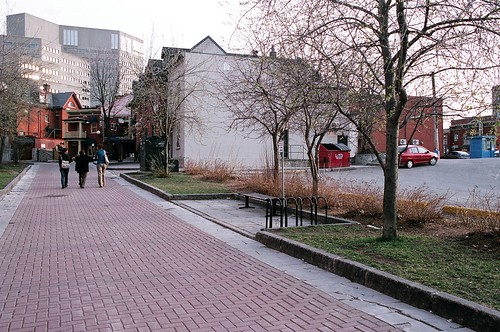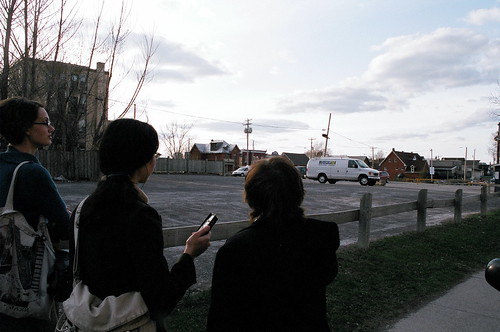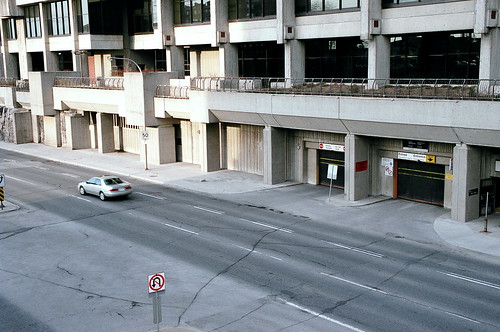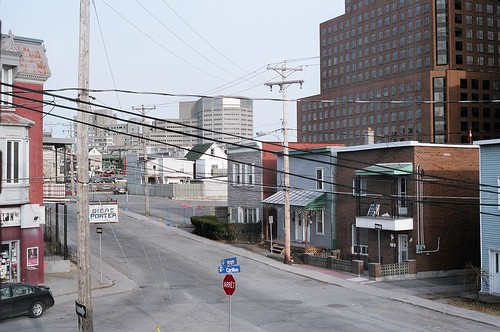
Ed: This piece by Spacing’s Ottawa/Gatineau Region correspondent Amber Yared is cross posted from SpacingToronto and continues the investigation (see first post here) into the many parking lots of downtown Hull:
Three Impervious P-lot personnel congregated for a second interview, this time in Hull with Historian Consultant Michelle Guitard.
We sought out Guitard to find out exactly what used to be where the parking lots are now. As we had suspected, buildings had been there; but it was more lucrative for property owners to tear them down and build parking lots or to lease the land to parking lot entrepreneurs than to maintain the old buildings. Guitard walked us through the streets and pointed to the ghosts of homes, restaurants, cinemas, and hotels. The block of parking pictured below used to be a funeral parlour, several houses, and a hall that was the first theatre and radio station in Hull.

Guitard informed us that the grey and brown federal complexes, built in the 1970s, had contributed to the growth of parking lots and the destruction of a French professional and working-class community:
“So the 1970 architectural concept of government buildings … First of all it’s grey, as you see. And when it’s not grey, it’s brown. The idea was to be able to go from one building to another without ever going on the street, so they destroyed the street. I want to show you this.

“This used to be restaurants, bookstores, pharmacies, different stores. So this whole street was very busy. City hall was over here, shops, restaurants, offices, doctors’ offices, lawyers’ offices with people living on top. What you see now is an indoor parking lot. They have destroyed the street completely. It looks almost as if it was a fortification without any outside walls. It’s not only parking on the streets that has destroyed the city; but also the parking underground that makes walls on the street.”
The more Guitard told us, the more I was shocked. I had imagined that beautiful old houses had been demolished to be replaced by p-lots, but I was completely overwhelmed by the contrast between the society Guitard described and what I saw before me now. The parking lots and many of the dead, unused spaces surrounding them were once alive with buildings and people. How could this have happened?
MG: When I see this, like it is now, it is unbelievable because everybody from the streets around would walk up and down to see if they would meet anybody. It was full of people. Across the street where there is this ugly building, there was a very nice cinema. One there and one there. …There you have another beautiful spot of parking lots! Again, along here where these parking lots are now, there were houses.
AY: So what was the reaction? Did people fight it?
MG: Very much… when it started… when they started to make the plans to construct the government buildings. They destroyed complete neighbourhoods; so naturally they contested. Many of the owners of shops thought that it would bring them money—that the people working for the government would come here and work here. But that’s not what happened. They were so afraid of anything going on in Hull that they would go to Ottawa with their money. Many of the banks closed and the shops went completely pffft! Many of the citizens that used to buy didn’t buy. Most people who used to live here moved to Aylmer or Gatineau and they started shopping there. They didn’t come back on the main street to buy. So there was a complete degradation of the heart of the city and of the social relationships between people because they were spread everywhere else. The population of the island of Hull went from 22,000 to 9,000 – of people living, not people working, but living.

Which brings us to the obvious reason why Hull has as many parking lots as it does; thousands of people who are not residents of Hull work in the massive brown and grey government buildings, and probably the majority of them bring their cars with them.
Amber Yared is one among a group of artists, writers, educators, and architects working on The Impervious P-lot, a Hull-based CUP project about parking lots and what they do besides store cars. She will be posting her findings on Spacing blogs as the project progresses.
